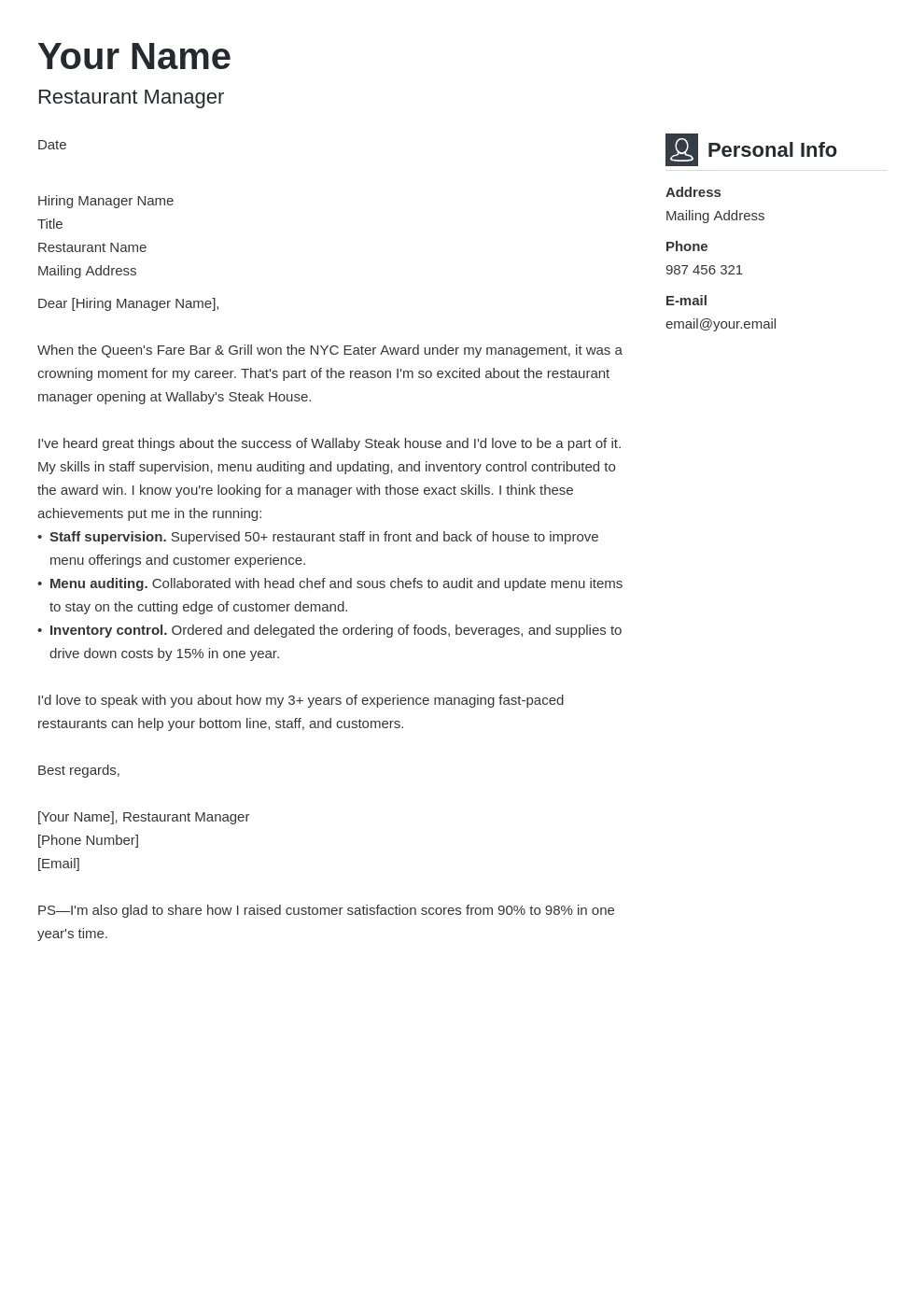Crafting a Winning Restaurant Cover Letter
A well-crafted cover letter is your first impression on a potential employer in the competitive restaurant industry. It’s your opportunity to showcase your skills, experience, and personality, setting you apart from other applicants. This guide will provide you with the essential components and strategies to create a compelling restaurant cover letter that gets you noticed and, ultimately, lands you the job. From understanding industry nuances to tailoring your letter for specific roles, we’ll cover everything you need to know to ace your application. Let’s get started on crafting a cover letter that opens doors to your dream restaurant job!
Understanding the Restaurant Industry
Before you begin writing, it’s vital to understand the specific demands and expectations of the restaurant industry. Restaurants are dynamic environments that value teamwork, customer service, and efficiency. Researching the restaurant’s style (fine dining, casual, fast food) and its values is crucial. Do they emphasize a specific cuisine, or do they prioritize a particular dining experience? Understanding these factors will enable you to tailor your cover letter to resonate with the hiring manager. Knowing what the restaurant values will allow you to highlight the experiences and skills that align with their culture. This preparation will significantly increase your chances of making a strong initial impact.
Researching the Restaurant and the Role
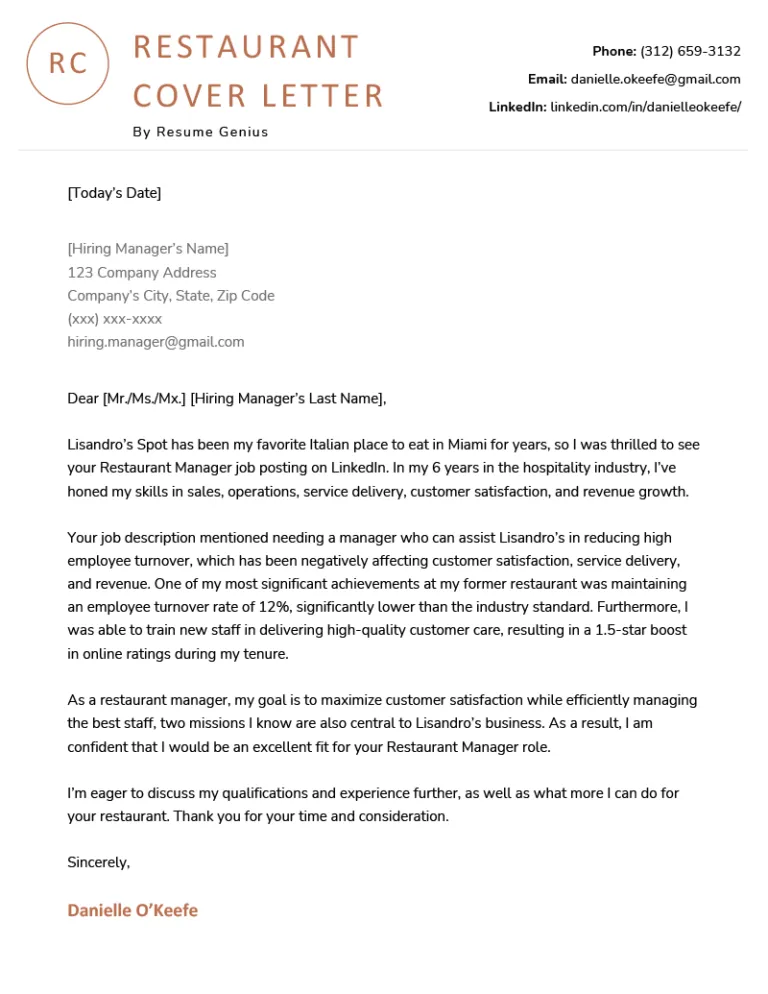
Thorough research is non-negotiable. Visit the restaurant’s website, social media pages, and online reviews. This will give you insights into their menu, ambiance, and customer service style. Study the job description carefully. Identify the key skills and qualifications the restaurant is looking for. Then, ask yourself how your experience and skills align with their requirements. Personalize your cover letter by referencing specific details from your research. For example, you can mention a dish you admire or highlight the restaurant’s commitment to a particular value. Showing that you understand their brand and role demonstrates genuine interest and initiative. Use this opportunity to set yourself apart from those sending generic applications. (Image: restaurant-research.webp)
Key Components of a Restaurant Cover Letter
A well-structured cover letter should include specific elements that create a professional and persuasive application. Each component serves a purpose in conveying your suitability for the role. Including the correct information in the right format will assist the hiring manager in grasping your qualifications. Ensuring you pay attention to all the crucial details will increase your prospects of success. Let’s break down the important segments you must use to craft a winning cover letter.
Contact Information and Date
Start with your contact information (name, address, phone number, and email address) at the top of the letter. Include the date below your contact details, followed by the hiring manager’s name (if known), title, and the restaurant’s address. This establishes professionalism and makes it easy for the employer to contact you. If you’re unsure about the hiring manager’s name, research on LinkedIn or call the restaurant to inquire. Addressing the letter to a specific person shows that you’ve taken the time to personalize your application and will earn you extra points.
Greeting the Hiring Manager
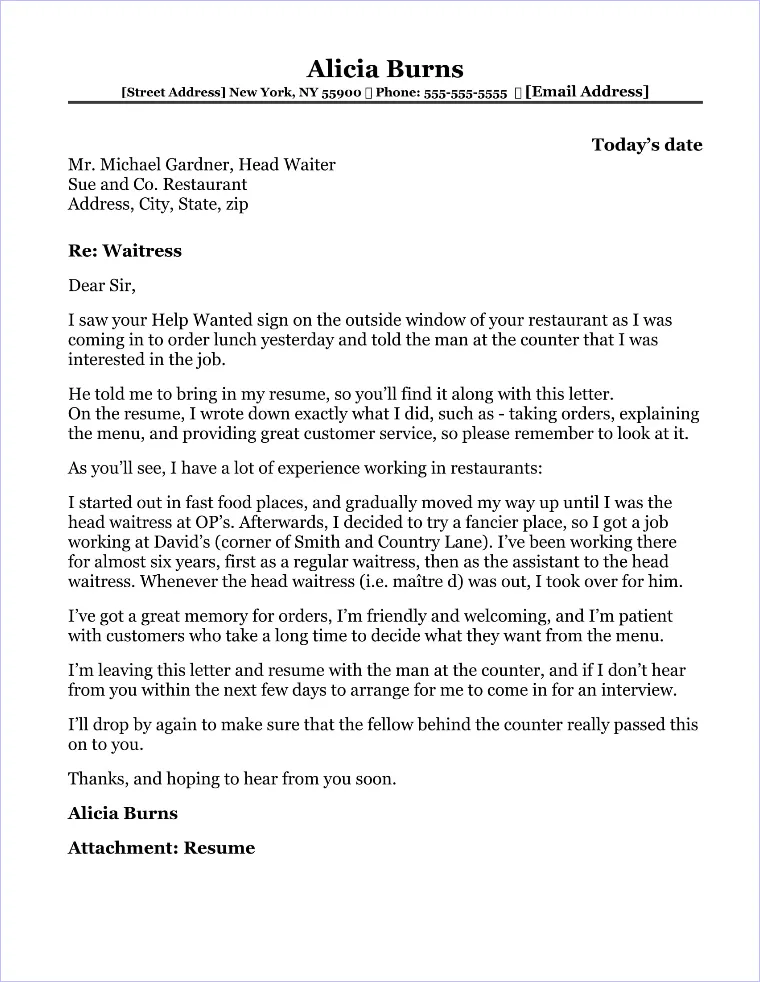
Use a professional greeting such as “Dear Mr./Ms. [Last Name]” if you know the hiring manager’s name. If you don’t, use “Dear Hiring Manager” or “Dear Restaurant Team.” Avoid generic greetings like “To Whom It May Concern.” A personalized greeting immediately captures attention and reflects your attention to detail. It indicates that you have invested time in your application, which is essential for any candidate. This simple step makes the hiring manager feel valued and shows that you care about the role. The greeting is a crucial step in establishing a positive first impression.
Opening Paragraph Grab Their Attention
The opening paragraph is your chance to make a strong first impression. Start with a concise and engaging statement that clearly states the position you are applying for and where you saw the job posting. Show enthusiasm and mention something specific that attracted you to the restaurant or the role. This could be their reputation, a recent achievement, or a particular aspect of their menu. A captivating introduction should also express your excitement and quickly demonstrate why you are a suitable candidate. Avoid generic phrases and emphasize what makes you unique. Show them that you bring something unique to the restaurant.
Highlighting Your Relevant Skills and Experience
This is the core of your cover letter. Describe your experience and skills that align with the job requirements. Provide specific examples of your accomplishments and how you have contributed to previous employers’ success. Include skills such as customer service, teamwork, food preparation, POS system proficiency, and any other relevant qualifications. When describing your past experiences, use the STAR method (Situation, Task, Action, Result) to provide context and illustrate your abilities. Ensure you tailor this section to match the restaurant’s needs and the job’s demands. This targeted approach will ensure you are perceived as a good fit. (Image: restaurant-cover-letter-skills.webp)
Quantifying Your Achievements
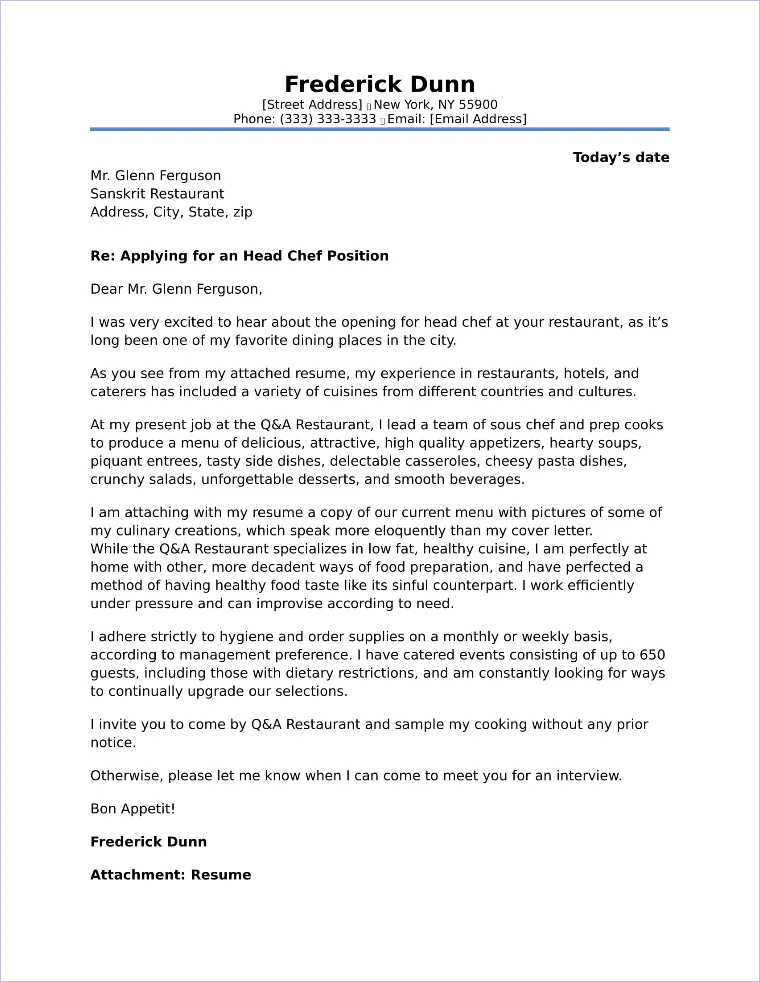
Whenever possible, quantify your achievements with numbers and data. Instead of saying “Improved customer satisfaction,” say “Increased customer satisfaction scores by 15% through proactive service.” This shows the impact of your work and provides concrete evidence of your capabilities. Quantifiable achievements make your claims more believable and make it easier for the hiring manager to assess your value. Use specific numbers to show your accomplishments: such as the number of customers served, the percentage increase in sales you achieved, or the amount of money you saved the company. Quantifying your achievements showcases your accomplishments more effectively.
Using Action Verbs
Use strong action verbs to describe your experience and skills. Verbs like “managed,” “led,” “implemented,” “trained,” and “achieved” create a dynamic and engaging narrative. Instead of using passive language, use verbs that showcase your initiative and capabilities. For instance, “Managed a team of ten servers” is more impactful than “Was responsible for managing a team of servers.” Action verbs make your accomplishments more impactful. The use of action verbs enhances your presentation and clearly highlights what you brought to your former roles. This gives the reader a vivid picture of your contribution.
Demonstrating Your Passion for the Industry
Show your passion for the restaurant industry. Express your enthusiasm for the restaurant’s cuisine, service style, or values. Mention your interest in learning and growing within the industry. If you have a favorite dish on their menu or admire their commitment to sustainability, mention it. Authenticity resonates with employers. Passion is infectious, and showing genuine enthusiasm can significantly increase your chances of getting the job. Sharing your interest makes you appear not only experienced but also a great fit for the restaurant’s work environment. (Image: restaurant-cover-letter-passion.webp)
Closing the Letter and Call to Action
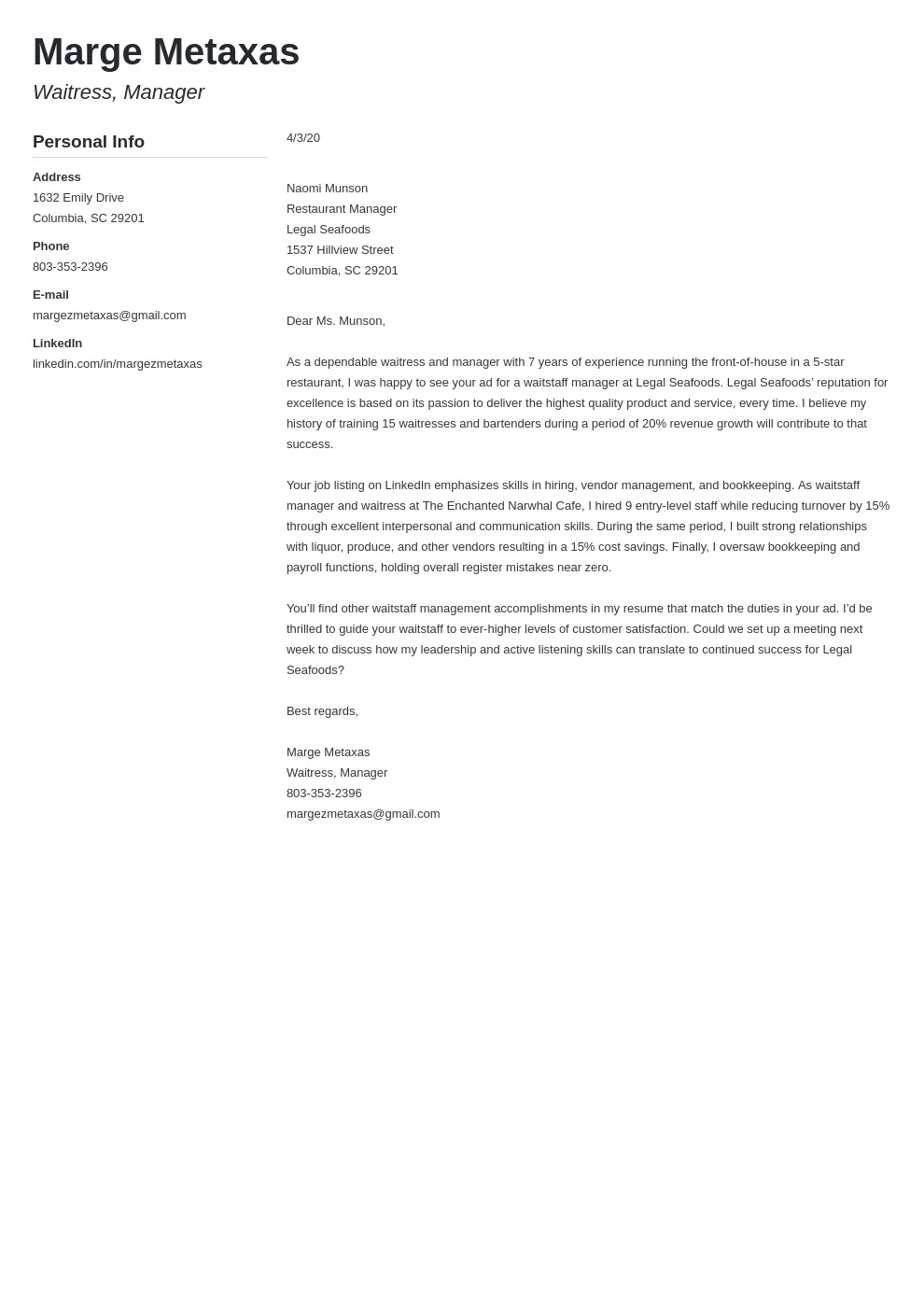
Conclude your cover letter with a strong call to action. Thank the hiring manager for their time and consideration. Reiterate your interest in the position, and express your willingness to discuss your qualifications further in an interview. Include a statement indicating that you are available for an interview at their earliest convenience. Providing your contact information again will ensure that they can easily reach you. End your letter with a professional closing such as “Sincerely” or “Best regards,” followed by your name. The closing is your last chance to convince the recruiter you are a great fit for the role.
Proofreading and Formatting Your Cover Letter
Before submitting your cover letter, meticulously proofread it for any grammatical errors, spelling mistakes, or typos. Errors can damage your credibility and signal a lack of attention to detail. Ensure that the formatting is consistent and visually appealing. Use a readable font (like Arial or Times New Roman), and keep the text well-spaced and organized. A clean, well-formatted cover letter reflects professionalism and makes it easier for the hiring manager to read and comprehend your message. This is also the last opportunity to make a great impression. Careful proofreading can set your cover letter apart and increase your chances of getting hired.
Common Mistakes to Avoid
Several common mistakes can undermine the effectiveness of your cover letter. Avoid generic language and templates that fail to demonstrate your individual qualifications. Don’t simply repeat your resume. Instead, provide additional information and highlight the most relevant aspects of your experience. Always proofread your cover letter to correct spelling and grammatical errors. Don’t include irrelevant details or personal opinions that do not contribute to your application. Make sure to address your letter to the right person. Avoid sounding negative or desperate, and focus on a positive attitude. (Image: restaurant-cover-letter-mistakes.webp)
Formatting Tips for Readability
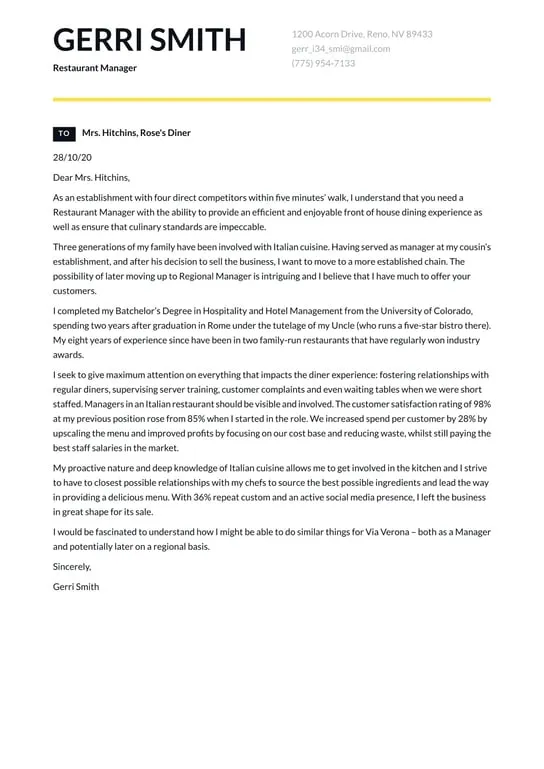
Good formatting is essential to make your cover letter easy to read. Use a professional font style, such as Times New Roman, Arial, or Calibri, and maintain a consistent font size. Keep the font size between 10 and 12 points. Use standard margins (1 inch on all sides) and single-space your text with a space between each paragraph. Use bullet points to highlight key skills and achievements, making the information easier to digest. Organize your content into clear paragraphs with a logical flow. Avoid excessively long paragraphs, and use headings and subheadings to break up the text. These tips will improve the readability and make a favorable impression on the reader.
Tailoring Your Cover Letter to Specific Roles
Tailoring your cover letter to the specific role demonstrates that you have carefully considered the job description and the requirements. Make sure that you adjust your cover letter based on the position. Show the hiring manager why you are the best choice for the job by including your most relevant skills and experiences for the role. For example, if you are applying for a serving position, focus on your customer service abilities, communication skills, and experience with taking orders and handling payments. Your goal is to create a compelling application for the role. Always show your interest and qualifications related to the role.
Cover Letter for Server Positions
When applying for a server position, emphasize your customer service skills, ability to work in a fast-paced environment, and your experience in handling customer requests and complaints. Highlight your knowledge of menu items, ability to upsell, and experience with POS systems. Detail any experience with handling cash and credit card transactions accurately. Mention your teamwork abilities and your capacity to cooperate with kitchen and other restaurant staff. Include any relevant certifications, such as a food handler’s card or alcohol server training. Always showcase your ability to provide excellent customer service and create a positive dining experience. (Image: server-cover-letter.webp)
Cover Letter for Cook/Chef Positions
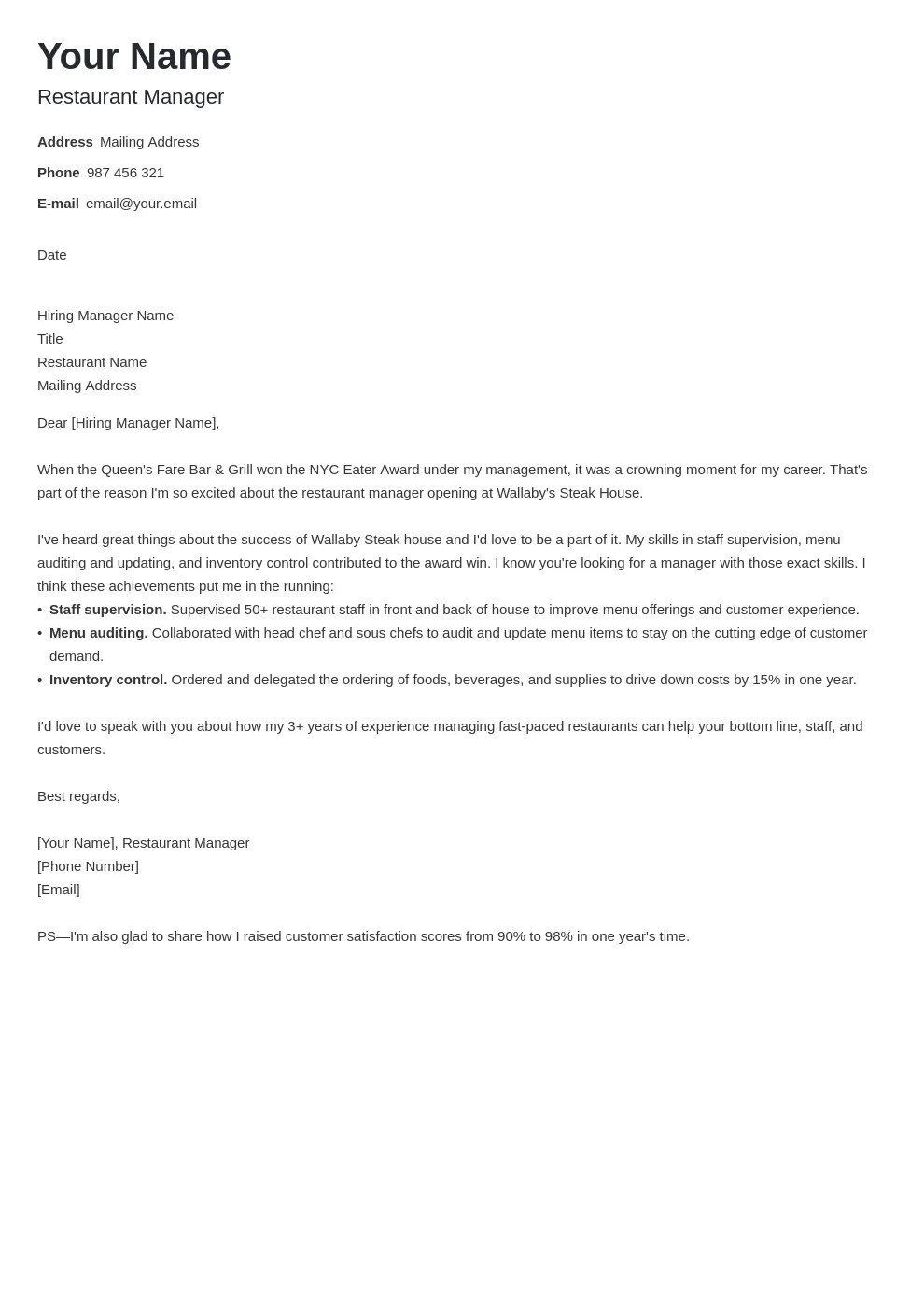
If applying for a cook or chef position, emphasize your culinary skills, experience with various cuisines, and knowledge of food safety and sanitation. Highlight your experience with menu planning, inventory management, and food preparation techniques. Include details about your experience in cooking, such as types of cooking skills, and specialty cuisines. Showcase your experience with operating kitchen equipment, and any relevant certifications, such as a culinary degree or food safety certification. Demonstrate your passion for cooking, ability to work under pressure, and commitment to creating high-quality dishes. Use specific details about your experience and how you contribute to the success of a kitchen. (Image: chef-cover-letter.webp)
Cover Letter for Managerial Roles
For managerial roles, highlight your leadership skills, experience in managing teams, and knowledge of restaurant operations. Detail your experience in hiring, training, and scheduling staff. Describe your skills in handling customer complaints, managing budgets, and increasing sales. Highlight your ability to enforce company policies, maintain a positive work environment, and ensure customer satisfaction. Include any certifications or training related to restaurant management. Show your capacity for leading and developing restaurant staff. Emphasize any achievements in previous management roles, such as increased profits or improved customer satisfaction scores. Detail your experience with restaurant management software or POS systems.
Reviewing Cover Letter Examples
Reviewing cover letter examples can provide valuable insights into what works and what doesn’t. Look for examples that are specific to the restaurant industry and to the position you are applying for. Analyze the structure, tone, and content of successful cover letters. Pay attention to how the applicants highlight their skills and experience, and how they tailor their letters to the specific requirements of the job. Using these resources can provide you with templates and ideas to create your own effective restaurant cover letter. This will help you to create a convincing and original cover letter to get the role.
